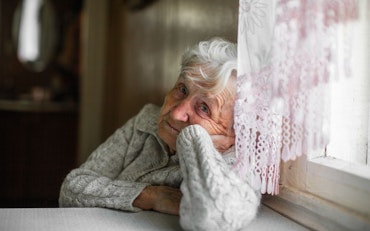COVID-19 super spreader variant causing havoc in aged care sector
With the aggressive spread of the new COVID-19 variant, Omicron, and the Government’s new attempt at a COVID-normal approach, aged care facilities around Australia are experiencing unprecedented workforce and equipment shortages across the board.
![<p>The aged care sector is currently experiencing stresses and shortages across the board due to COVID-19 outbreaks. [Source: Shutterstock]</p>](https://agedcareguide-assets.imgix.net/news/articles/news/articles/11_1_2022-Covid-in-aged-care.jpg?fm=pjpg&format=auto&w=550&q=65)
The aged care sector is currently experiencing stresses and shortages across the board due to COVID-19 outbreaks. [Source: Shutterstock]
Aged care facilities across the country have chronic shortages in staff, COVID-19 Rapid Antigen Tests (RATs), and Personal Protective Equipment (PPE).
Paul Sadler, the Chief Executive Officer of Aged and Community Services Australia (ACSA) – peak body for not-for-profit aged care providers – says the situation is pretty dire in aged care and there is huge pressure on residents, staff and aged care facilities.
“We have the Government saying there were 500 aged care homes with outbreaks last Friday. It’s likely that it will double by the end of this week because every indication from our members is that they’re getting outbreaks at every service in areas where there is high community transmission of Omicron,” explains Mr Sadler.
“So there is immense pressure on aged care services. It is having a really significant impact on staffing availability. We now have organisations telling us they’ve got anywhere between five and 50 percent of their staff who either directly [have] COVID themselves or have been deemed close contacts.
“That has been, as you can imagine, an immense challenge for services to actually provide continuity of care for older people both in aged residential care and in home care.”
Last Friday, the Government released interim changes to reduce close contact exposure requirements for aged care staff to ensure continuity of care.
Tim Hicks, General Manager Policy, Advocacy and Advisory at Leading Age Services Australia (LASA) – peak body for aged care services – says that due to the huge impact on the aged care workforce and the essential nature of aged care services, these changes are necessary in some circumstances to make sure older people still receive the care they need.
If necessary, a close contact staff member can still go to work if they do regular and consistent testing and follow risk mitigation measures, such as additional PPE, avoiding shared spaces, and adjusting rosters to minimise exposure to staff and residents.
“We have been facing a workforce shortage for quite some time, [COVID-19] is just exacerbating that,” says Mr Hicks.
Supply lines to deliver RATs to aged care facilities and services, which the Federal Government made free to aged care providers, have either been disrupted or those lines have disappeared.
Mr Sadler says LASA has heard from facilities that have been waiting six days or more for RAT deliveries to turn up while also having a COVID-19 outbreak in their home at the same time.
Mr Hicks adds that the stockpiles are there but some of these supplies are being prioritised to specific services, and the number of RAT supplies facilities would need to take a cautionary approach is “astronomical”.
A lack of PPE has also become present in aged care facilities and services, Mr Sadler says, with supply lines impacted even though the stockpiles are there.
“In terms of PPE, we thought we had left behind the problems of not having masks and gowns and so on. It has come back to haunt us this time round because, again, the supply chain, the delivery capacity of trucking companies have all been interrupted. We are finding services that are struggling to actually have enough PPE for staff,” says Mr Sadler.
However, the delivery of booster shots to aged care residents through in-reach clinics at facilities has ramped up with around 1,700 out of 2,658 aged care homes having an in-reach clinic as of Monday.
This is 70 percent of aged care homes that have previously had a clinic for residents, but there is still 30 percent to go.
Mr Sadler says the Federal Government has indicated that it is aiming to have in-reach booster clinics in the remaining 30 percent of facilities before the end of January.
For aged care staff, there is no nation-wide mandate to get a booster shot with the onus currently placed on States and Territories to decide. So far, Western Australia, Victoria and South Australia have mandated booster shots for aged care workers.
Mr Sadler is hoping for the Government to provide greater guidance to aged care homes that is nationally consistent in areas like how to furlough staff (leave of absence due to positive COVID case or close contact) and how to apply public health ordered restrictions on aged care services.
“I don’t think any aged care provider in the country would disagree that we have a problem with COVID in aged care,” says Mr Hicks.
Survey results reinforces concerns in aged care
A survey by the Health Services Union (HSU) of over 1,000 aged care workers found that staff are dealing with excessive workloads and extended shifts in conjunction with supply concerns on RATs, vaccine boosters and PPE.
President of HSU National, Gerard Hayes, says that these issues facing aged care facilities and staff could have been avoided if the Federal Government prepared the sector for the current COVID-19 outbreaks.
“The Government comprehensively failed to plan before allowing Omicron to rip through the community and modestly paid workers, and residents in aged care facilities who built this country, are paying the price,” says Mr Hayes.
“Only just over a third of members surveyed have received their booster shot, despite working overtime in high risk settings.
“There are active outbreaks in almost 500 aged care facilities across the country. Yet workers can’t access RATs, they can’t access PPE. They are on the front line with very little protection.
“Not only are staff at risk but vulnerable residents are at a heightened risk of severe disease or death.”
The survey found that:
- 82 percent of workers believe their aged care facility was unprepared for the “current Omicron ‘let it rip’ approach”
- 90 percent are experiencing understaffing
- 84 percent are experiencing excessive workloads
- 36 percent are working in facilities that have implemented 12 hour shifts
A further 39 percent of HSU member survey participants have had to isolate due to exposure and only 16 percent of those had access to paid isolation leave.
Mr Hayes says, “The Government has effectively abandoned the sector under the premise of living with the virus.
“Aged care workers are exhausted and frustrated and residents are terrified. The Federal Government needs to take action today.”










